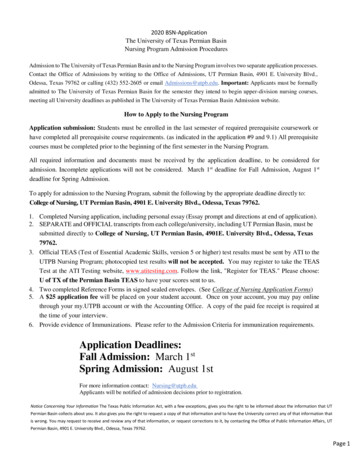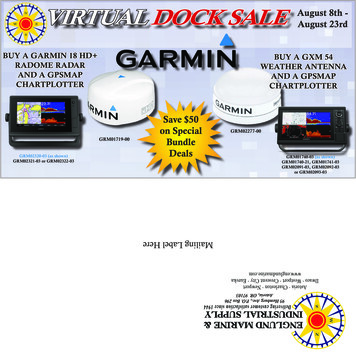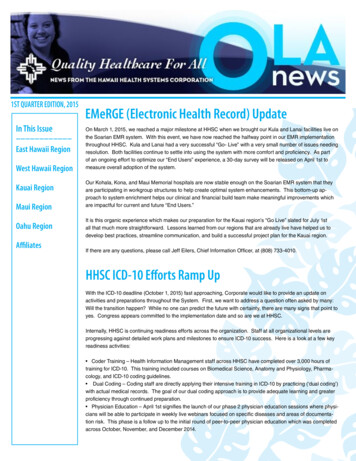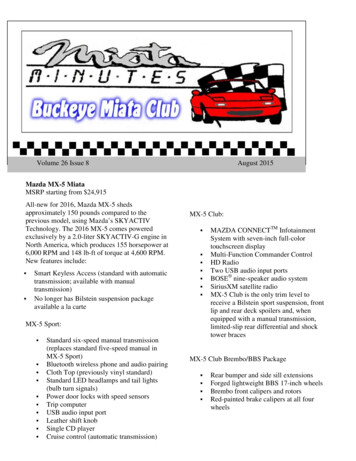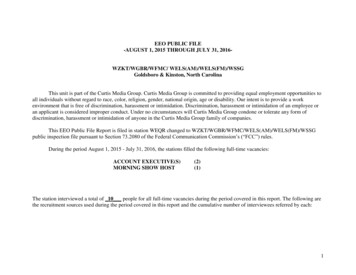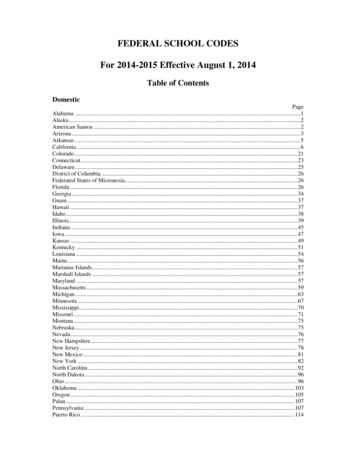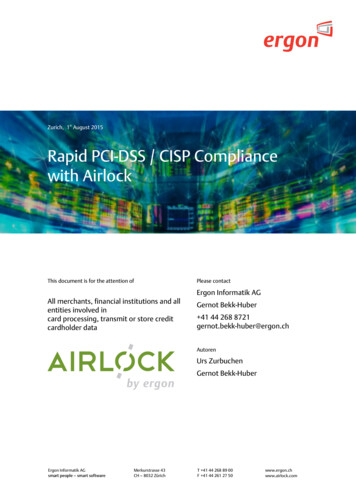
Transcription
stZurich, 1 August 2015Rapid PCI-DSS / CISP Compliancewith AirlockThis document is for the attention ofPlease contactErgon Informatik AGAll merchants, financial institutions and allentities involved incard processing, transmit or store creditcardholder dataGernot Bekk-Huber 41 44 268 8721gernot.bekk-huber@ergon.chAutorenUrs ZurbuchenGernot Bekk-HuberErgon Informatik AGsmart people – smart softwareMerkurstrasse 43CH – 8032 ZürichT 41 44 268 89 00F 41 44 261 27 50www.ergon.chwww.airlock.com
Table of contents1.Why should I care about the Payment Card Industry Data Security Standard (PCI DSS)?32.Rapid PCI Compliance with Airlock WAF43.Detailed Requirements of the PCI Standard and Benefits of Airlock SuiteBuild and Maintain a Secure Network (Requirements 1 – 2)Protect Cardholder Data (Requirements 3 – 4)Maintain a Vulnerability Management Program (Requirements 5 – 6)Implement Strong Access Control Measures (Requirements 7 – 9)Regularly Monitor and Test Networks (Requirements 10 – 11)Maintain an Information Security Policy (Requirement 12)55557774.Summary of PCI DSS Compliance with Airlock Suite8The data security standard of the payment card industry (PCI DSS) became effective by end ofSeptember 2007. The current version of the PCI DSS is V3.1 from April 2015. Every company thatdoes not protect credit card data or transactions sufficiently will face severe consequences andpenalties. The web application security solution Airlock Suite combines a web application firewall(Airlock WAF) and an identity and access management solution (Airlock Login / IAM) andsignificantly helps to comply with the strict security standard. Copyright 2015Ergon Informatik AGsales@airlock.comairlock.com2/8
1.Why should I care about the Payment Card Industry Data SecurityStandard (PCI DSS)?What is worse than being attacked by a hacker? Not even knowing about it! Other than a few yearsago, Hacker attacks today are highly motivated by organized criminal backgrounds and financialbenefits. Hacker attacks on the application level are most of the times not even recognized. Stealingcredit cardholder data is the most typical example for a successful and silent hacker attack.Sophisticated attack methods are continuously improved by hackers and present a huge risk to allcompanies who process, transmit or store credit cardholder data.Threatened by today’s application level attacks, the PCI Security Standards Council has been createdto provide a common data security standard across all payment brands. Founders of the PCI SecurityStandards Council are the major credit card companies such as American Express, Discover FinancialServices, JCB, MasterCard Worldwide and Visa International. The Payment Card Industry DataSecurity Standard (PCI-DSS) describes 12 security requirements to ensure safe handling of sensitiveinformation and prevent attacks against cardholder data and transactions.All merchants, financial institutions and all entities involved in card processing, transmit or storecredit cardholder data have to comply with the standard. Non-compliance will lead to restrictions,fines and additional fees. A special focus of the Payment Card Industry Data Security Standard is onpreventing attacks on the application layer. All applications are concerned as the following quotefrom the PCI DSS clearly shows:“System components are defined as any network component, server, or applicationthat is included in or connected to the cardholder data environment. The cardholderdata environment is that part of the network that possesses cardholder data orsensitive authentication data.” “Applications include all purchased and custom applications, including internal andexternal (Internet) applications.”More information about the Payment Card Industry Data Security Standard (PCI DSS) canbe found at the Web site of the PCI Security Standards Council:http://www.pcisecuritystandards.orgAirlock provides the Web Application Firewall (WAF) Airlock WAF and the Identity and AccessManagement Solution Airlock IAM that significantly help you to comply with the PCI Data SecurityStandard while lowering costs at the same time. Section 6.6 of the PCI DSS recommendsimplementing a Web Application Firewall for application level security tasks. Copyright 2015Ergon Informatik AGsales@airlock.comairlock.com3/8
2.Rapid PCI Compliance with Airlock WAFAirlock Suite dramatically reduces time, efforts, complexity and costs in achieving compliance withthe standard. In contrast to competitive products, Airlock covers the whole Web application securityrequirement scope and efficiently helps to meet the PCI requirements regarding the protection ofapplications. Copyright 2015Ergon Informatik AGsales@airlock.comairlock.com4/8
3.Detailed Requirements of the PCI Standard and Benefits of Airlock SuiteThe PCI Data Security Standard describes the following 12 security requirements. For at least 7 outof the 12 requirements, Airlock instantly helps to comply with the standard.Build and Maintain a Secure Network (Requirements 1 – 2)PCI Requirement 1 & 2: Install and maintain a firewall configuration to protect cardholder data. Donot use vendor supplied defaults for passwords and other security parameters. The first tworequirements describe today’s best practice for a multi-tier network architecture with a DMZ,network firewalls, routers, switches, application servers, databases, etc. All incoming/outgoingconnections have to be described in a network firewall policy and justified. Frequent reviews of thefirewall and router rule sets are required to verify the implementation of the policy. As a focusedWeb Application Firewall (WAF), Airlock WAF is placed behind the perimeter network firewall tospecifically validate and analyze all Web application traffic (HTTP/ HTTPS). It therefore supportsrequirement 1 as a Web Application Firewall with specific security functions on the Web applicationlayer. Requirement 2 needs to be fulfilled and documented in a policy to comply with the standard.Protect Cardholder Data (Requirements 3 – 4)Requirement 3: Protect stored cardholder data. This requirement clearly states the importance ofsafe handling of sensitive credit cardholder data and the way it is stored (either electronically or onprint-outs etc.). PCI auditors check for storage policies and how they are implemented. You need todescribe carefully how cardholder data is stored and how the stored data is protected. The WebApplication Firewall Airlock WAF does not help with this requirement as it does not store applicationdata.Requirement 4: Encrypt transmission of cardholder data across open, public networks. Thisrequirement is provided as a core function (SSL termination) by Airlock WAF. Airlock WAF providesconvenient mechanisms to handle SSL certificates, CRLs and it supports hardware accelerated SSLtermination as well as HSMs for secure private key storage. The applications do not have to deal withSSL and its vulnerabilities in any way; it’s all offloaded to Airlock WAF! With automatic virtualpatching functionalities new vulnerabilities can be fixed within hours over all applications.Maintain a Vulnerability Management Program (Requirements 5 – 6)Requirement 5: Use and regularly update anti-virus and malware software. This requirementdemands active and up-to-date Anti-Virus solutions to protect the applications againstviruses/worms/ trojans. You need to make sure that an updated Anti-Virus solution is in place,especially on user PCs in your company network. Regarding the security of your application servers,Airlock WAF significantly leverages your investment into the Anti-Virus solution as the WebApplication Firewall supports file upload Anti-Virus scanning via the ICAP interface. All uploadcontent to the applications is checked against viruses/worms/trojans on-the-fly by Airlock WAF.Especially for Web applications where users may upload files this is a key benefit. Additionally,Airlock WAF provides a positive security enforcement module with a multi-stage filtering engine andURL encryption mechanisms that prevent viruses or worms to get to your applications.Requirement 6: Develop and maintain secure systems and applications. This requirement and itssub-requirements are the new core of the PCI Data Security Standard regarding application securityenforcement. It is the requirement where Airlock WAF presents its key functions and USPs to helpyou to comply with the PCI Data Security Standard. Airlock WAF is developed with a clear focus onthese requirements. Experience of leading business enterprises has shown that the applicationsecurity requirement is very complex to be met over time. Only a dedicated and focused productsuch as Airlock WAF makes it possible to address the different aspects of the problem in a unified,cost-efficient and easy-to-use way. Let’s look into the details of requirement 6 to get a better picture: Copyright 2015Ergon Informatik AGsales@airlock.comairlock.com5/8
Requirement 6.1 demands latest security patches to be installed for your systems. However, there isalways a period of time (between finding the vulnerability and the patch release) where the systemis exposed to a certain wide-spread vulnerability (so-called “zero day” exploits). Airlock WAF protectsapplications against known and even unknown attacks. Therefore, as an additional positiveprotection layer, Airlock WAF significantly reduces the pressure of patching and the operations teamgets back into a pro-active mode of work instead of reactive.Requirement 6.2 demands a process to identify new security vulnerabilities. Same as with 6.1:Airlock WAF greatly reduces the risk because the Web Application Firewall protects against knownand even unknown attacks with its positive security model.Requirement 6.3 demands integrated security into the development of the application source codeand throughout the development life cycle. It is definitely good advice to comply with best practiceregarding security relevant issues in the development cycle as it is described in 6.3. However,experience shows that it is not sufficient and secure code is a myth. The problem is that theapplication development life cycle is driven by functional requirements. On the other hand thesecurity threat scenario is unlimited and a new attack method may occur just the next day. Therewill be no application development team available on call just to improve the application instantly todeal with it. Even if there are application developers around to do it, it is not be cost-effective and itrequires a whole application release deployment (including analyzing, coding, QA, live testing,productive deployment) whenever a security problem is recognized. Last but not least, the PCI DataSecurity Standard requires all applications to be protected, also purchased 3rd party products thatcannot be adapted quickly to specific customer needs. Airlock WAF focuses on protecting any Webapplication environment independent if custom built or purchased. It dramatically reduces therequirements for integrated security into existing application source code and provides realcomprehensive Web application security. Instead of implementing all security functions repeatedlyinto each application, Airlock WAF provides a sophisticated set of security functions for all Webapplications at the same time. As a focused Web Application Firewall, Airlock WAF stays up-to-dateand protects the applications even against most recent attacks.Requirement 6.4 demands strict change control procedures for all system and softwareconfiguration changes.Even if this requirement results in a well-documented policy and procedure, Airlock WAF significantlysimplifies change control mechanisms for Web application with its virtual application mappings andthe independent security policies.Administrators can create different configuration sets in parallel and easily switch between them.Requirement 6.5 summarizes typical application level vulnerabilities and demands secure codingguidelines similar to 6.3 in order to achieve secure application code. As mentioned for 6.3, securecode is a myth and it is practically impossible to keep application code on a high security level overtime. It is definitely good advice to follow secure coding guidelines but it is not sufficient. AirlockWAF provides a multi-level filtering engine with cryptographic URL encryption and HTML formprotection that protect Web applications successfully against the mentioned vulnerabilities. Becausethe positive security model of Airlock WAF dynamically protects the application at runtime, evenunlisted and unknown attacks are prevented. Secure authentication and session management orbroken authentication can also be handled centrally over all applications.Requirement 6.6 demands regular source code reviews by external third parties to maintain thedesired level of security over time or to install a Web Application Firewall (WAF). As outlined in 6.3and 6.5 it is a good idea to follow best practice and secure coding guidelines. In order to keep thesecurity level high over time while keeping the costs low it is much more efficient to install the WebApplication Firewall Airlock WAF! The PCI DSS also recommends to implement a Web ApplicationFirewall because it provides the desired level of security instantly for all applications and makes iteasier to keep the applications continuously protected over time. Copyright 2015Ergon Informatik AGsales@airlock.comairlock.com6/8
Implement Strong Access Control Measures (Requirements 7 – 9)Requirement 7: Restrict access to cardholder data by business need-to-know. This requirement issupported by Airlock WAF and Airlock IAM by providing secure access and session control for Webapplications and application parts for different user groups. Based on the authenticated sessioncredentials Airlock WAF only lets users access the applications if they are entitled to.Requirement 8: Assign a unique ID to each person with computer access. This requirementdemands unique user IDs that can be tracked. Airlock WAF provides strong multi-factorauthentication enforcement combined with secure session handling providing unique user ID andeven unique request IDs that can be tracked within the sophisticated log analyzer. Airlock WAFsimplifies the integration of strong authentication by offloading it from the application’s businesslogic. Additionally, it provides detailed monitoring and reporting functions on the tracked users andsessions. With Airlock IAM you can manage the number Login attempts, automatic session timeoutsafter 15 minutes idle, automatic password expiration and much more centrally. Strong userauthentication, token management user management over the whole life cycle including user selfservices and proper user-authentication management can be implemented over all applications onone central point.Requirement 9: Restrict physical access to cardholder data. This requirement demands policies andprocesses to guarantee physical security mechanisms to access cardholder data. You need to makesure that physical access to cardholder data is protected and that physical access policies are welldocumented. Again strong authentication is needed to protect card holder data.Regularly Monitor and Test Networks (Requirements 10 – 11)Requirement 10: Track and monitor all access to network resources and cardholder data Thisrequirement demands overall monitoring functions to track all Web application activity. Airlockprovides a sophisticated monitoring and reporting engine that provides detailed information aboutall application requests enriched with user and session information. As a central securityenforcement unit in front of the Web application servers, Airlock provides comprehensive logmessages and events for your whole Web application environment, independent of the specificapplication being used. With an interface for Splunk you can generated aggregated managementreports in a ready to us product. The fully integrated solution from Qumram achieves legallycompliant data archiving and cross channel recording over all web applications.Requirement 11: Regularly test security systems and processes. This requirement demands regulartests of the involved systems and processes. It is best practice to perform penetration tests on aregular basis to verify the implementation of the security policies. The penetration test will alsoshow you that the Web Application Firewall Airlock WAF prevents your Web applications from beingattacked.Maintain an Information Security Policy (Requirement 12)Requirement 12: Maintain a policy that addresses information security. This requirement addressesthe need for well documented policies that need to be communicated to employees andcontractors. Copyright 2015Ergon Informatik AGsales@airlock.comairlock.com7/8
4.Summary of PCI DSS Compliance with Airlock SuiteAs described in the previous sections, Airlock Suite instantly helps to meet at least 7 out of the 12 PCIDSS requirements. Many requirements of the PCI DSS are also found in other security complianceregulations and are therefore important “best practice” guidelines for responsible companies thatuse Web applications for parts of their business. Airlock strictly focuses on providing IT securitysolutions on the application level. Don’t hesitate to contact us to discuss your open questions withus regarding the most efficient way to achieve a high level of application security while keepingcosts low. Copyright 2015Ergon Informatik AGsales@airlock.comairlock.com8/8
Sep 30, 2019 · Rapid PCI-DSS / CISP Compliance with Airlock . A special focus of the Payment Card Industry Data Security Standard is on . Management Solution Airlock IAM that significantly help you to comply with the PCI Data Security Standard while lowering cost

